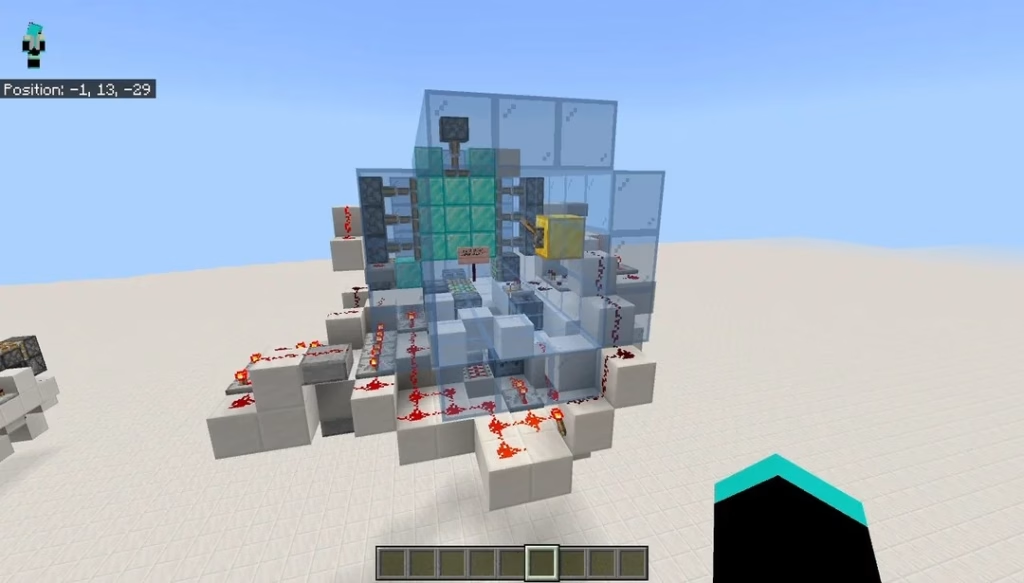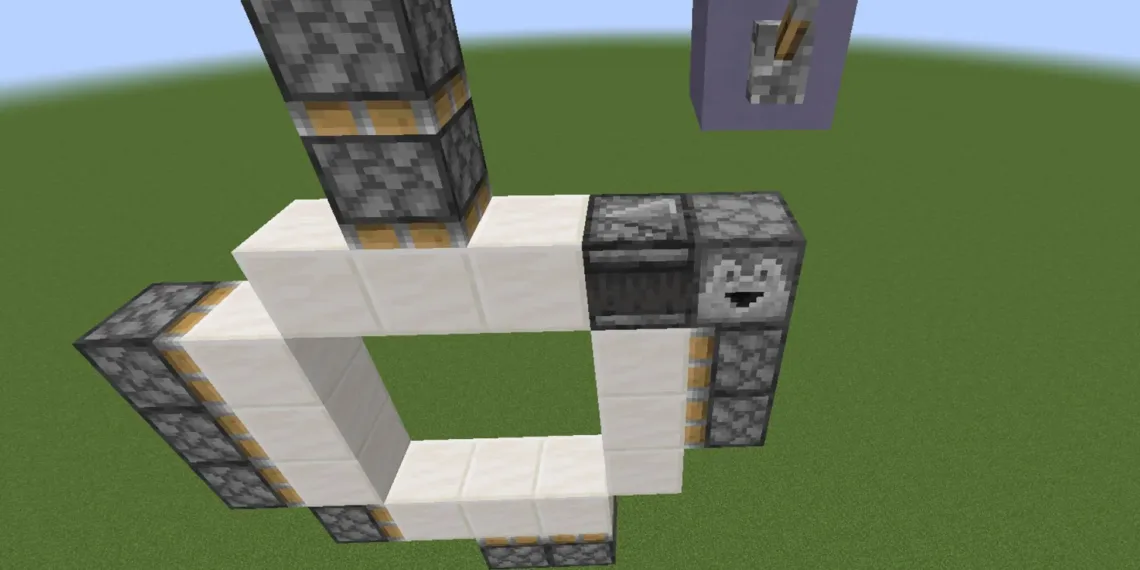The Minecraft community just witnessed another mind-blowing redstone innovation that challenges everything we thought we knew about automatic doors. Reddit user u/KurtGoedle shared a revolutionary design—a fully functional 3×3 automatic door that doesn’t use a single piston. Yes, you read that right: zero pistons.
Table of Contents
Minecraft Pistonless Innovation Explained
Traditional automatic doors in Minecraft rely heavily on pistons to push blocks in and out of position. But this creative build completely reimagines the mechanism using gravity blocks and bubble columns to create seamless opening and closing action.
The genius lies in its simplicity: sand and gravel blocks fall down to open the doorway, then rise back up through a column of bubbling water powered by soul sand or magma blocks. It’s physics-based engineering at its finest, and surprisingly, it requires minimal redstone knowledge compared to complex piston-based contraptions.

How the Mechanism Works
| Component | Function | Purpose |
|---|---|---|
| Sand/Gravel Blocks | Door material | Falls to open, rises to close |
| Soul Sand | Bubble column generator | Creates upward water current |
| Water Source | Transport medium | Carries blocks vertically |
| Redstone Circuit | Trigger mechanism | Activates door opening/closing |
| Observers | Detection system | Monitors block movement |
The build operates on a straightforward principle: when triggered, the sand and gravel blocks drop down layer by layer, creating an opening. To close, the water’s upward current—generated by soul sand placed at the bottom—lifts the blocks back into position. Each layer shuffles through sequentially, creating a mesmerizing visual effect.
Why This Build Matters
Simplicity Over Complexity: Unlike traditional piston doors that require extensive redstone wiring, timing mechanisms, and precise piston placement, this design is remarkably straightforward. Even players with basic redstone understanding can construct it successfully.
Resource Efficiency: Pistons require iron ingots, which can be scarce early in gameplay. This design uses readily available materials—sand, gravel, soul sand, and basic redstone components—making it accessible for survival mode players.
Compact Design: The mechanism doesn’t require the bulky space that piston arrays demand, making it ideal for bases with limited room for hidden machinery.

Community Reactions and Improvements
The Minecraft subreddit exploded with excitement and creative suggestions. Reddit user u/PotatoesAndChill discovered that concrete powder works perfectly in this system since the powder only hardens when stationary—while constantly moving through water, it remains in powder form. Testing confirmed this works flawlessly on Bedrock Edition.
Another user, u/Angstor, praised the aesthetic appeal of watching each layer shuffle through sequentially, adding visual flair to functional engineering.
Want to master more Minecraft building techniques? Check out our comprehensive Minecraft redstone guide on Technosports for tutorials ranging from beginner circuits to advanced automation systems.
Building Your Own Pistonless Door
Materials Needed:
- 9 blocks of sand or gravel (3×3 door)
- Soul sand (for bubble column)
- Water buckets
- Basic redstone dust
- Observers
- Lever or pressure plate
Step-by-Step Process:
- Create the frame: Build a 3×3 doorway frame in your desired location
- Dig beneath: Excavate below the door area to create space for falling blocks
- Install soul sand: Place soul sand at the bottom with water above to generate bubble columns
- Position blocks: Stack your sand/gravel blocks in the doorway
- Wire redstone: Connect observers to detect block movement and trigger the mechanism
- Test and adjust: Fine-tune timing to ensure smooth operation
For detailed tutorials and official Minecraft mechanics, visit the official Minecraft website for comprehensive building guides and community showcases.
Creative Variations to Try
Concrete Powder Door: Replace sand with concrete powder for a colorful aesthetic that won’t harden due to constant water movement.
Double-Wide Design: Scale up to a 6×3 door using the same principles for grand castle entrances.
Hidden Entrance: Disguise the door with matching blocks and hide the lever for secret base access.
Explore more creative Minecraft builds and gaming content at Technosports for inspiration and community-shared designs.
Advantages Over Traditional Piston Doors
Beyond the obvious benefit of not requiring pistons, this design offers several practical advantages:
- Silent Operation: No loud piston sounds alerting nearby players in multiplayer
- No Slime Blocks Required: Traditional flying machine doors often need hard-to-find slime
- Survival-Friendly: All materials are easily obtainable without extensive mining or trading
- Expandable: The concept scales to larger or smaller door sizes with minimal adjustments
The Future of Redstone Innovation
This pistonless door represents a broader trend in the Minecraft community—finding innovative solutions to conventional problems using unconventional methods. Players continue pushing creative boundaries, demonstrating that even after years of gameplay, new discoveries remain possible.
From computers running inside Minecraft to working displays and even ChatGPT-like systems, the community’s technical creativity knows no bounds. This pistonless door adds another fascinating entry to that impressive list.
Frequently Asked Questions
Q: Will this door work in both Java and Bedrock editions?
A: Yes! Community testing confirmed the pistonless door functions in both editions. However, slight timing adjustments may be necessary due to subtle differences in how each version handles block updates and water mechanics. The concrete powder variant specifically received confirmation for Bedrock Edition, though Java players should also find it works smoothly with minor tweaking.
Q: Can I use this door design in the Nether where water doesn’t work?
A: Unfortunately, no. The entire mechanism relies on water’s upward current created by soul sand bubble columns to lift the blocks back into position. Since water evaporates instantly in the Nether, this design won’t function there. For Nether bases, you’ll need to stick with traditional piston-based doors or explore alternative designs using fire, lava, or other Nether-compatible mechanics. Consider building your secret entrance in the Overworld portion of your base instead.






